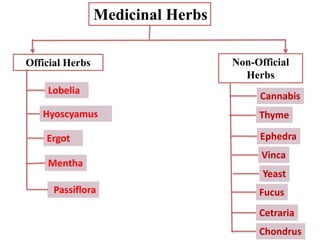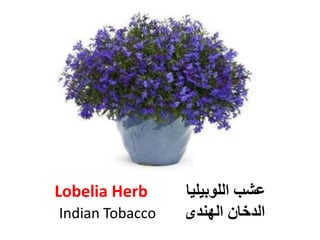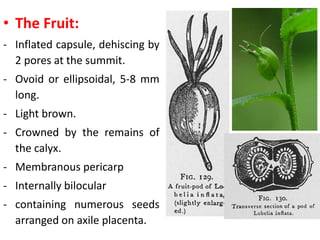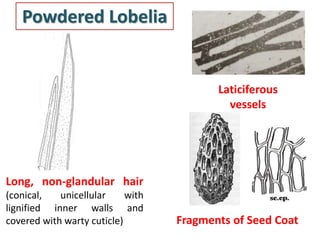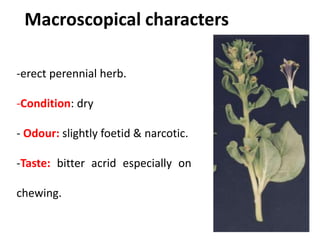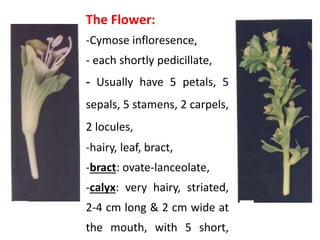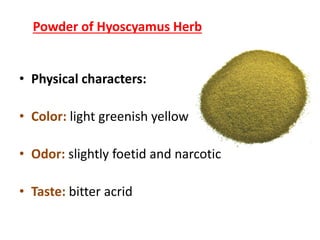Herb 1
- 2. Examination of the Stem • 1- Macroscopical characters: - Condition: - Shape - Colour - Nodes and internodes - Phyllotaxis - Surface - Fracture - Odour - Taste
- 3. Medicinal Herbs Lobelia Hyoscyamus Mentha Thyme Ergot Ephedra Passiflora Official Herbs Non-Official Herbs Cannabis Vinca Yeast Fucus Cetraria Chondrus
- 4. Lobelia Herb اللوبيليا عشب Indian Tobacco الهندى الدخان
- 5. Lobelia Herb اللوبيليا عشب Indian Tobacco الهندى الدخان • Origin: - The dried aerial parts of Lobelia inflata Linn. Family: Campanulaceae, collected towards the end of the flowering stage. - It is used by North American Indians as domestic medicine as a cigarette for asthma.
- 6. Macroscopical characters - erect annual herb, 40-60 cm. - Odour: slight irritant. -Taste: at first slight but subsequently burning and acrid.
- 7. • The Stem: - Monopodial branching. - Angular to winged. - Irregularly furrowed. - Green to yellowish with large purplish patches. - Hairy on the upper parts and nearly glabrous on the lower.
- 8. • The Leaves: - alternate. - Pale green. - Scattered stiff hairs along the margin and veins on the outer surface. - The lower leaves are oblong, shortly petiolate. - The upper leaves are small, oval to lanceolate, sessile, with irregularly crenate, dentate margin.
- 9. • The Flowers: - shortly pedicillate. - arranged in long racemes. - pale blue about 7 mm long. - Calyx: tubular with 5 long linear teeth. - Corolla: tubular, bilabiate. - Stamens: with blue anthers, united above, forming a curved tube enclosing bifid stigma each anther ends with a tuft of hairs at the apex. - Ovary: inferior, bilocular, bicarpellary.
- 10. • The Fruit: - Inflated capsule, dehiscing by 2 pores at the summit. - Ovoid or ellipsoidal, 5-8 mm long. - Light brown. - Crowned by the remains of the calyx. - Membranous pericarp - Internally bilocular - containing numerous seeds arranged on axile placenta.
- 11. • The Seeds: - minute - oval oblong, 0.5-0.7 mm long and about 0.3 mm wide. - reddish brown with fine elongated polygonal reticulations.
- 14. • Physical characters: • Color: green to dark green • Odor: slight irritant • Taste: at first slight but subsequently burning and acrid. Powder of Lobelia Herb
- 15. Powdered Lobelia Long, non-glandular hair (conical, unicellular with lignified inner walls and covered with warty cuticle) Laticiferous vessels Fragments of Seed Coat
- 16. Woody fibres Fragments of stem and leaves showing beaded papillosed epidermal cells, anomocytic stomata and hairs. Xylem vessels
- 17. Fragments of brown seed coat showing characteristic thick walled lignified epidermal cells
- 18. Active constituents • 1- About (0.3- 0.4 %) piperidine alkaloids, the important of these are Lobeline, Lobelanine and Lobelanidine. • 2- non-acrid but pungent volatile oil. • 3- Neutral principle, inflatin. • 4- Lobelic acid. • 5- resin and waxes.
- 19. Uses • 1- Lobelia has a nicotine like action, so its used in breaking of smoking habit.
- 21. 3- as expectorant and in treatment of cough. 4- An injection of Lobeline hydrochloride is used in resuscitation of new-born infants. 5- Large doses produce vomiting and may cause collapse through medullary paralysis. 2- In bronchitis & bronchial asthma as it has a bronchodilator effect.
- 22. Side Effects and Toxicity: -Extreme care should be taken with the use of Lobelia inflata to control asthma and as a remedy in general. - It has been known to be toxic even at relatively low doses and in some countries this herb is scheduled. -Toxic doses of lobelia will give rise to symptoms such as nausea, vomiting, convulsions and can be fatal.
- 24. Hyoscyamus Herb المصرى السكران Egyptian Hyoscyamus Egyptian Henbane
- 25. Hyoscyamus Herb المصرى السكران Egyptian Hyoscyamus Egyptian Henbane Botanical Origin: The dried leaves and flowering tops of Hyoscyamus muticus Linn., Family: Solanaceae. Geographical Source: It is a perennial herb, indigenous and cultivated in Egypt. It grows wild in the districts of Egypt.
- 26. -erect perennial herb. -Condition: dry - Odour: slightly foetid & narcotic. -Taste: bitter acrid especially on chewing. Macroscopical characters
- 27. The Stem: - cylindrical, slightly compressed - succulent, - greyish yellow, - slightly hairy, -hollow with hairy branches.
- 28. The Leaves: - pale green to yellowish, - petiolate or nearly sessile, hairy, -vary in shape and size, - lamina: oval, rhomboidal to broadly elliptical, up to 15 cm long, - apex: tapering to an equal base and accuminate, - margin: entire or with 2-5 triangular acute teeth on each side, - both surfaces densely hairy, - mid-rib: broad, prominent on the lower surface, -Venation: pinnate.
- 29. The Flower: -Cymose infloresence, - each shortly pedicillate, - Usually have 5 petals, 5 sepals, 5 stamens, 2 carpels, 2 locules, -hairy, leaf, bract, -bract: ovate-lanceolate, -calyx: very hairy, striated, 2-4 cm long & 2 cm wide at the mouth, with 5 short,
- 30. -Corolla: dried yellowish, sometimes with deep colored patches, zygomorphic funnel shaped. -Stamens: 5-epipetalous, unequal in length, with purplish filaments and brownish and sometimes purplish anthers. - Ovary: ovoid superior, bicarpellary, bilocular, slightly hairy containing numerous campylotropous ovules attached to axile placenta.
- 31. The Fruit: - Pyxis enclosed in the calyx, - Cylindrical, - 1.5 cm long & 0.6 cm broad.
- 32. The Seed: -yellowish-grey to brown in color, - more or less reniform, - laterally compressed, - about 1mm. long with reticulate testa, -Internally shows a curved embryo embedded in an oily endosperm.
- 33. T.S of Hyoscyamus Leaf
- 35. • Physical characters: • Color: light greenish yellow • Odor: slightly foetid and narcotic • Taste: bitter acrid Powder of Hyoscyamus Herb
- 36. Twin and prism crystals of Calcium oxalate Powder of Hyoscyamus Herb Glandular hairs Non-Glandular hairs
- 37. Epidermal cells with anisocytic stomata Spherical pollen grains with finely pitted exine lignified seed coat
- 38. Microscopically: 1. Presence of anisocytic stomata. 2. Presence of uniseriate, 3 to 5 celled non- glandular hairs. 3. Presence of glandular hairs with short or long stalk & multicellular, club-shaped head (clavate hair). 4. Presence of different types of Ca-Ox crystals.
- 39. Active Constituents: • Tropane Alkaloids (0.7 – 1.5 %) mainly Hyoscyamine other alkaloids as Hyoscine, atropine and nor- atropine.
- 40. General uses: Externally: Local anaesthetic, relieve pain. Internally: - Reduce secretions e.g. sweat, saliva thus used before surgery. - Anti spasmodic in urinary tract colics & gripping effect caused by the purgatives (corrective antispasmodic). - Sedative for spasmodic cough.
- 41. • Special chemical test: • Vitali’s test (Morin color test) • for tropane alkaloids (Solanaceous alkaloids) • Alcoholic extract evaporation in porcelain dish residue + 2 drops of fuming HNO3, heat till dryness , cool + add 3 drops of alcoholic KOH violet color.


